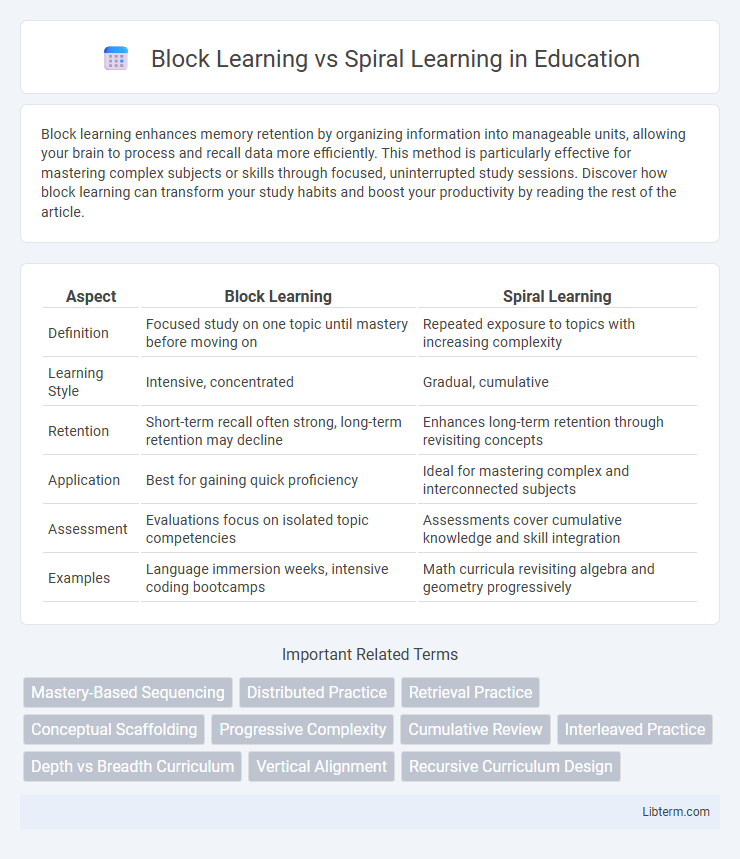Block learning enhances memory retention by organizing information into manageable units, allowing your brain to process and recall data more efficiently. This method is particularly effective for mastering complex subjects or skills through focused, uninterrupted study sessions. Discover how block learning can transform your study habits and boost your productivity by reading the rest of the article.
Table of Comparison
| Aspect | Block Learning | Spiral Learning |
|---|---|---|
| Definition | Focused study on one topic until mastery before moving on | Repeated exposure to topics with increasing complexity |
| Learning Style | Intensive, concentrated | Gradual, cumulative |
| Retention | Short-term recall often strong, long-term retention may decline | Enhances long-term retention through revisiting concepts |
| Application | Best for gaining quick proficiency | Ideal for mastering complex and interconnected subjects |
| Assessment | Evaluations focus on isolated topic competencies | Assessments cover cumulative knowledge and skill integration |
| Examples | Language immersion weeks, intensive coding bootcamps | Math curricula revisiting algebra and geometry progressively |
Introduction to Block Learning and Spiral Learning
Block Learning involves mastering a single topic intensively before moving to the next, enhancing deep focus and retention on specific subjects. Spiral Learning revisits topics periodically with increasing complexity, reinforcing knowledge and fostering long-term understanding through continuous review. Both methods target different cognitive processes, with Block Learning emphasizing concentrated study sessions and Spiral Learning promoting progressive reinforcement.
Definitions and Core Concepts
Block learning involves mastering one topic thoroughly before moving on to the next, emphasizing focused, intensive study sessions that promote deep understanding within a single domain. Spiral learning revisits the same topics multiple times at increasing levels of complexity, reinforcing knowledge through continuous exposure and gradual skill development. The core concept of block learning is concentrated mastery, while spiral learning centers on iterative reinforcement and integration of concepts over time.
Principles Behind Block Learning
Block Learning organizes content into discrete, concentrated units focused on mastering one topic before moving to the next, emphasizing deep immersion and intensive practice. This approach leverages cognitive load theory by reducing the mental effort required to switch between subjects, enhancing retention of complex skills through repetitive reinforcement. The principle of targeted focus in Block Learning contrasts with Spiral Learning's gradual revisiting of topics, aiming instead for mastery within a defined segment before progressing.
Principles Behind Spiral Learning
Spiral learning is based on the principle of revisiting key topics repeatedly over time, each time at a more complex and deeper level, which reinforces long-term retention and strengthens understanding. This approach contrasts with block learning, where subjects are studied intensively in isolated segments without systematic review. Emphasizing iterative exposure and progressive complexity, spiral learning aligns with cognitive science findings on memory consolidation and skill acquisition.
Key Differences Between Block and Spiral Learning
Block learning involves teaching one topic intensively before moving to the next, while spiral learning revisits topics repeatedly with increasing complexity over time. Block learning allows deep focus but may lead to memory decay, whereas spiral learning promotes long-term retention through periodic reinforcement. The key difference lies in pacing: block learning is linear and segmented, spiral learning is cyclical and integrated.
Advantages of Block Learning
Block learning allows for deep immersion in a subject, enhancing retention and mastery through concentrated study periods. This method reduces cognitive load by minimizing topic switching, leading to improved focus and efficient skill acquisition. Students benefit from structured, uninterrupted timeframes that facilitate comprehensive understanding and quicker application of concepts.
Advantages of Spiral Learning
Spiral Learning enhances long-term retention by revisiting topics at increasing levels of complexity, which reinforces understanding and builds deeper connections between concepts. This approach adapts to learners' cognitive development, ensuring mastery before progressing and minimizing knowledge gaps. It promotes active engagement and critical thinking by integrating new information with prior knowledge throughout the learning process.
Disadvantages and Challenges of Both Approaches
Block learning often leads to knowledge fragmentation, making it difficult for students to retain and integrate information over time. Spiral learning can cause cognitive overload as learners revisit complex concepts repeatedly, sometimes resulting in confusion and decreased motivation. Both approaches face challenges in balancing depth and breadth, requiring careful curriculum design to optimize knowledge retention and skill development.
Applications in Modern Education Systems
Block learning segments content into focused, intensive units, ideal for mastering complex subjects like coding bootcamps or language immersion programs where deep concentration is required. Spiral learning revisits topics progressively at increasing levels of difficulty, effective in K-12 curricula for subjects like mathematics and science, reinforcing retention and cognitive connections over time. Modern education systems leverage these methods by combining block learning for specialized skill acquisition and spiral learning for comprehensive curriculum development, enhancing adaptive learning environments.
Choosing the Right Approach: Factors to Consider
When choosing between Block Learning and Spiral Learning, consider the subject complexity, learner's retention capacity, and instructional goals. Block Learning suits mastery of contiguous topics with intensive focus, while Spiral Learning benefits long-term retention through revisiting concepts progressively. Evaluate learner engagement, content interconnectivity, and assessment design to optimize the educational impact.
Block Learning Infographic

 libterm.com
libterm.com